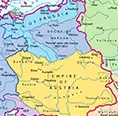Napoleon Bonaparte: Giant of the Age
Part 9: Trouble in the North In 1812, Napoleon had his focus on the east. Russia was, by the terms of the Treaty of Tilsit, bound not only to join the Continental System but also to declare war on the U.K. The latter happened, to a degree, but never to the extent that Napoleon wanted. The Continental System had closed Russian ports to ships from the U.K. (and vice versa), and those closures were having a significant impact on Russian revenues. Tsar Alexander also at this time was lobbying heavily for a way to get direct access to the Mediterranean, with one proposal being the seizure of Constantinople; Napoleon (and indeed, other European leaders) had opposed such a strategy. 
France and Russia had squabbled over territory formerly belonging to Poland as well. France had played a large part in creating the Duchy of Warsaw, which took territory from Prussia but was on Russia's doorstep, and had defeated Russian troops in Polish territory. In January 1810, Bonaparte vowed not to recreate the Kingdom of Poland. He did eventually refer to his invasion of Russia as the Second Polish War. In the end, Russia left the Continental System. The first break came in 1810 in the form of a Russian tax on all imports of luxury goods, including those from France. The following year, Russia opened its ports to shipments from the U.K. Also at this time, Scandinavian intrigue was heating up. The King of Sweden, Charles XIII, was very old and had no heir and so had designated as his successor the former French Marshal Jean-Baptiste Bernadotte, who had been thrown out of the army by Bonaparte for insolence and had fled to Sweden. Bonaparte offered to help Sweden retake Finland, but Bernadotte got a better offer from Alexander, in the form of assistance in conquering Norway–which, as a province of Denmark, was part of the French alliance. In April 1812, Russia and Sweden cemented an alliance with a treaty. The following month, Russia signed a peace agreement with Turkey. In July, Alexander signed a treaty of alliance with the U.K. Together, all of this meant that Russia could concentrate on fighting France without worrying about attacks coming from anywhere else. Sweden was also significant in that it contained a precedent for the French invasion of Russia. A century before, then-King Charles XII had invaded Russia, from his base in Poland, during the Great Northern War. After initial success, Charles eventually had to call off the invasion, in part because the Russian leader, Peter I, had adopted a scorched earth policy in order to deny the invaders any benefits from the land through which they marched. The Russian army defeated the Swedes in May 1709, at the Battle of Poltava. Of the 40,000 men in the Swedish army who began the invasion, in January 1708, Charles escaped with 543. He had lost the rest to battle and winter-induced starvation. Even though the war in Spain continued to go badly for France, Bonaparte ordered an invasion of Russia. In February 1812, before Russia had cemented its alliances with Sweden and the U.K., Bonaparte mobilized his very large army and called for reinforcements from Austria, Prussia, and France itself, including pulling French troops out of Spain. They began the move eastward in May. In all, more than 650,000 troops made up the invasion force. It was the largest such armed force ever assembled in Europe. The preparations for this invasion were monumental:
The French army, during its many years of warfare in recent memory, had become very good at foraging for supplies. That living off the land included not only seizing food, water, clothing, and other resources from the surrounding population but also profiting from the spoils of war in the form of assets seized taken from prisoners or from enemy dead. Bonaparte knew that much of the territory of western Russia would not lend itself to such a strategy, which is why the supply trains were so large and so burdened. At the time, the Russian army was split into two main forces, one on either side of the Pripet Marshes. To the south was Pyotr Bagration, and to the north was Michael Andreas Barclay de Tolly; combined, their forces numbered fewer than 500,000. To the north were Moscow and possibly St. Petersburg; to the north was also colder climates. To the south were Kiev and warmer climates; attacking to the south would also mean a longer route to Moscow. Bonaparte decided to attack north of the Pripet Marshes and aim to prevent the two Russian forces from meeting up. The plan was to confront the Russian armies, achieve a great victory, and convince Alexander to sue for peace and return to the kind of arrangement that the two leaders had crafted at Tilsit in 1807. Time and again, however, the Russians did not do what was expected. Next page > Disaster in Russia > Page 1, 2, 3, 4, 5, 6, 7, 8, 9, 10, 11, 12 |
|
Social Studies for Kids
copyright 2002–2025
David White



 The force included total of 200,000 animals. Of those, 80,000 were cavalry horses and 30,000 were artillery horses; none of them had winter horse shoes. The rest were draft animals, pulling wagons containing weapons and supplies.
The force included total of 200,000 animals. Of those, 80,000 were cavalry horses and 30,000 were artillery horses; none of them had winter horse shoes. The rest were draft animals, pulling wagons containing weapons and supplies. Also accompanying the army were the means to construct supply depots along the way.
Also accompanying the army were the means to construct supply depots along the way.
